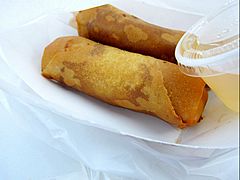Lumpiang gulay facts for kids
 |
|
| Alternative names | lumpiyang gulay, vegetable lumpia |
|---|---|
| Course | Appetizer |
| Place of origin | Philippines |
| Serving temperature | hot, warm |
| Main ingredients | lumpia wrapper |
| Variations | lumpiang togue vegetarian lumpia |
Lumpiang gulay, also known as vegetable lumpia, is a yummy Filipino appetizer. It's like a crispy fried roll filled with vegetables. Sometimes it also has a little bit of ground meat or shrimp.
The vegetables are cut into thin strips or small cubes. They are then wrapped in a thin egg crêpe (a special wrapper) and deep-fried until golden. A popular type of lumpiang gulay is lumpiang togue. This one is mostly made with togue, which are mung bean sprouts.
This dish has influences from both Spanish and Chinese cooking. Even though it's called "vegetable lumpia", it usually contains meat or shrimp. But don't worry, you can easily make a special vegetarian lumpia. This version uses only vegetables.
Contents
What is Lumpiang Gulay?
Lumpiang gulay is a delicious fried snack from the Philippines. It is known for having lots of vegetables inside. It's different from other lumpia types because it's always served fried.
Ingredients and How It's Made
Many different vegetables can go into lumpiang gulay. Common ones include carrots, sweet potatoes (called kamote), onions, garlic, and cabbage. You might also find potatoes, singkamas (jicama), green beans (sitaw), chayote (sayote), and mung bean sprouts (togue).
A small amount of ground meat, meat strips, or shrimp is often added. Sometimes, fish flakes are used too. The meat is cooked a little before the vegetables are mixed in. All these yummy fillings are then wrapped in a special lumpia wrapper. After wrapping, the rolls are deep-fried until they are crispy and golden brown.
How to Enjoy It
People usually eat lumpiang gulay by dipping it in a sauce. A popular choice is vinegar or a sweet and sour sauce called agre dulce. But you can use other dipping sauces too! Sometimes, this dish is also called lumpiang prito. This is a general name for any fried lumpia in the Philippines.
How It's Different from Other Lumpia
Lumpiang gulay stands out from other lumpia types, like lumpiang Shanghai. It has a much bigger amount of vegetables compared to meat. It's also usually thicker than lumpiang Shanghai because it has more filling.
Some other lumpia dishes, like lumpiang ubod or lumpiang labong, can be served either fresh or fried. But lumpiang gulay is always served fried.
Types of Lumpiang Gulay
There are a few fun variations of this popular dish.
Lumpiang Togue
Lumpiang togue is a very popular type of lumpiang gulay. It's also known as "bean sprouts lumpia." It's made in a similar way to regular lumpiang gulay. The main difference is that lumpiang togue uses a lot more togue (mung bean sprouts). These sprouts become the main ingredient, often replacing most of the cabbage found in other versions.
Vegetarian Lumpia
Even though lumpiang gulay usually has meat, you can easily make vegetarian versions. These vegetarian lumpia rolls don't use any meat at all. They often include mushrooms or tokwa (tofu) for extra flavor and texture.
Vegetarian lumpia can be served either fried (lumpiang prito) or fresh (lumpiang sariwa). If you want a version with seafood but no meat, you can make a pescetarian lumpia. This type uses only chopped shrimp or fish flakes.
For a completely vegan version, you would use only plant-based ingredients. You would also need to make sure the lumpia wrappers are vegan, meaning they don't contain eggs.
Lumpiang Gulay in Pop Culture
The vegetarian lumpia was shown on the Netflix TV series Street Food. It was featured in the episode about Cebu, Philippines.
See also
 In Spanish: Lumpia gulay para niños
In Spanish: Lumpia gulay para niños

